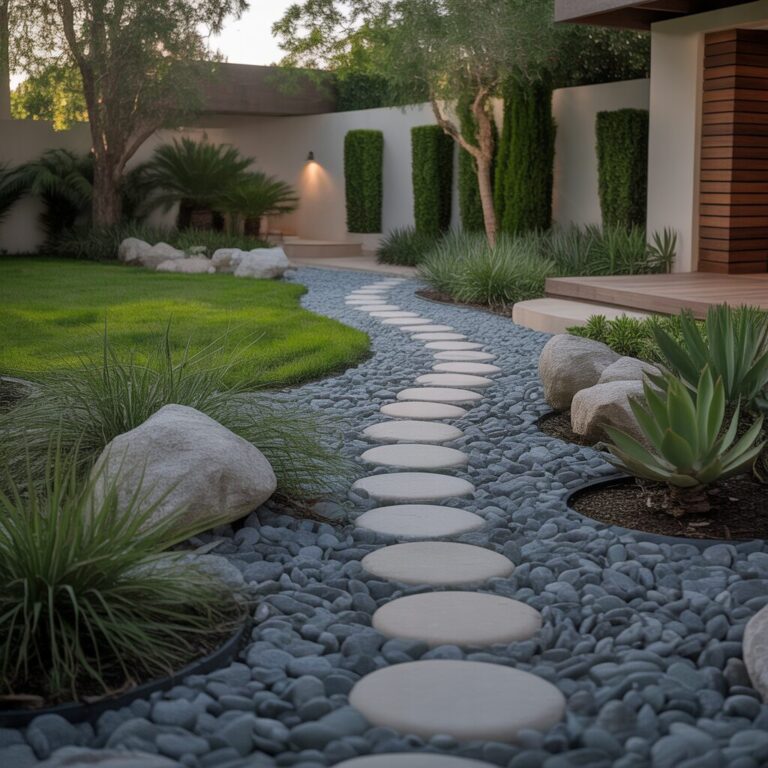10 Backyard Orchard Ideas: Transform Your Yard into a Fruitful Paradise
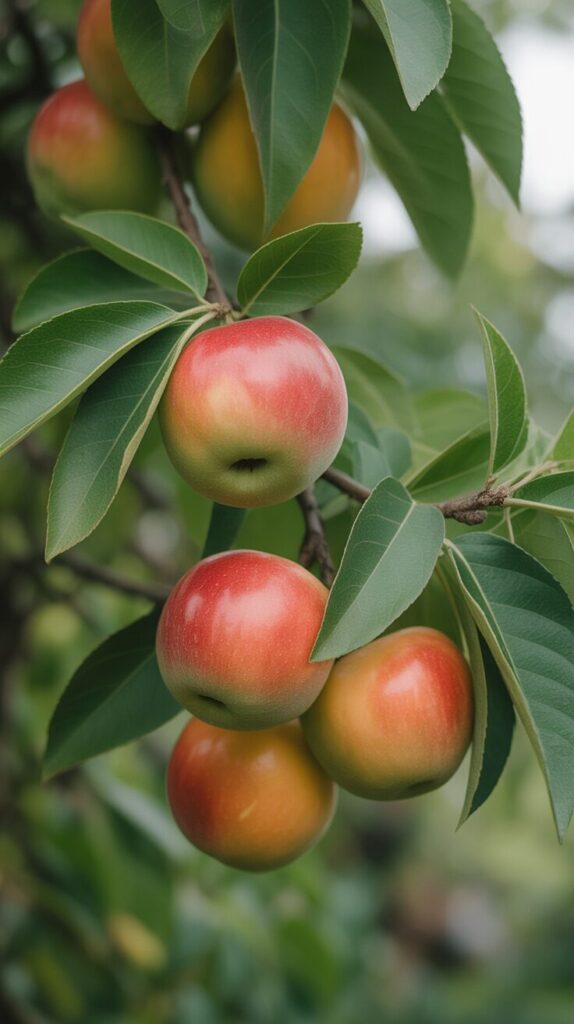
Imagine stepping into your backyard and harvesting fresh apples, peaches, or cherries straight from your own trees. A backyard orchard transforms ordinary outdoor space into a productive, beautiful landscape that provides fresh fruit for years to come while increasing property value and environmental benefits. Whether you have a sprawling lawn or a modest yard, there’s an orchard design that fits your space and lifestyle. From traditional layouts to innovative high-density plantings, these creative approaches make orchard ownership accessible to homeowners of all experience levels. Discover ten inspiring backyard orchard ideas that will help you cultivate your own fruit-growing paradise.
1. Classic Row Orchard Layout
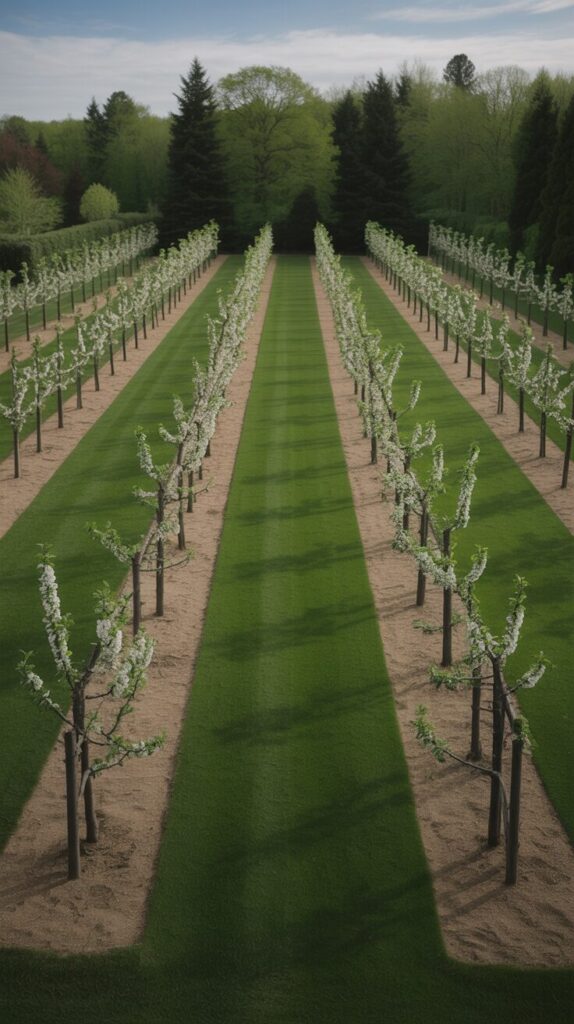
Plant fruit trees in parallel rows with consistent spacing to create a traditional orchard aesthetic that maximizes growing space and simplifies maintenance routines. Position rows running north-south to ensure even sunlight distribution on both sides of each tree throughout the day, promoting balanced growth and fruit production. Space standard trees 15-20 feet apart with 20-25 feet between rows, or use dwarf varieties with 8-10 feet spacing for smaller yards. This organized arrangement makes mowing, spraying, and harvesting straightforward since you can move systematically through the orchard without missing areas. The classic layout also creates beautiful seasonal displays with orderly blossom rows in spring and abundant fruit-laden branches in summer and fall.
2. Backyard Food Forest Design
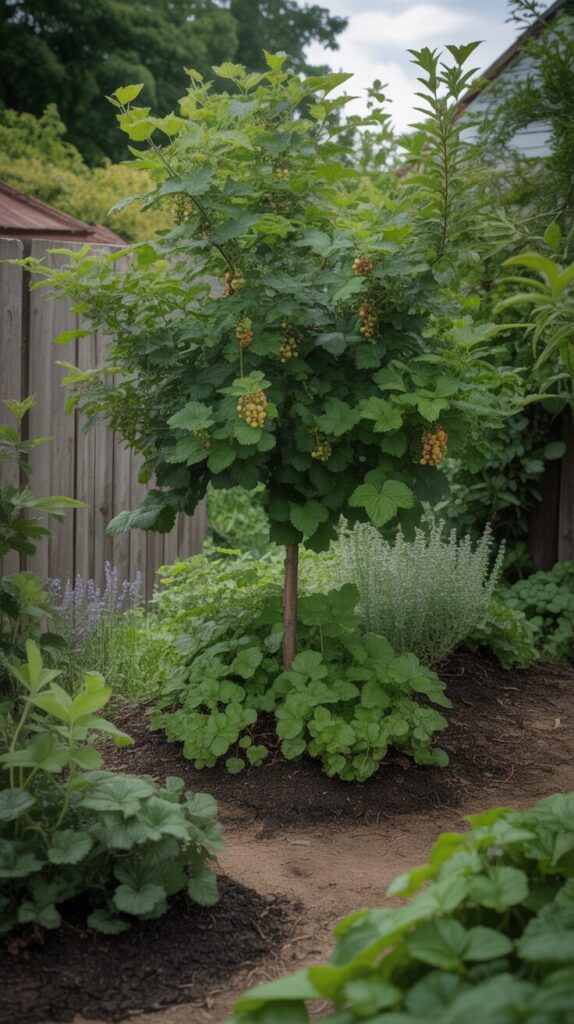
Develop a multi-layered edible ecosystem by combining fruit trees with berry bushes, perennial vegetables, herbs, and nitrogen-fixing plants in guilds. Plant larger fruit trees as the canopy layer, then fill understory spaces with shade-tolerant currants, gooseberries, and rhubarb beneath their branches. Add ground covers like strawberries and creeping thyme to suppress weeds naturally while providing additional harvests throughout the growing season. This permaculture approach mimics natural forest ecology, creating a self-sustaining system that requires minimal intervention once established and mature. The diverse plantings attract beneficial insects and pollinators while building healthy soil through natural decomposition and nutrient cycling processes.
3. Espalier Fence Line Orchard
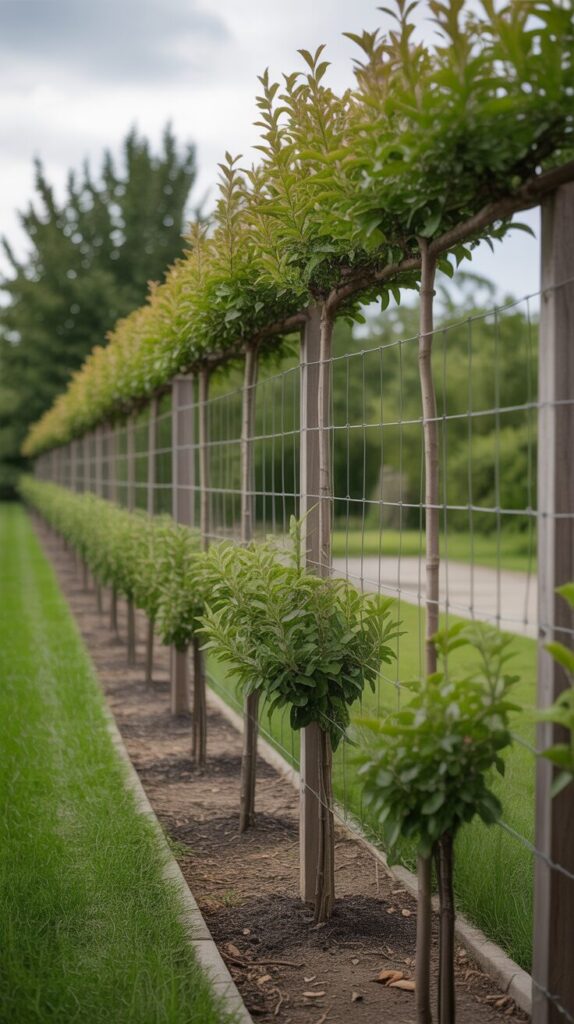
Train fruit trees flat against existing fences, walls, or wire trellises to create productive boundaries that save space while adding architectural interest. This technique works exceptionally well with apples, pears, and stone fruits that can be pruned into horizontal tiers, fans, or decorative patterns. Espalier trees require only 12-18 inches of growing depth, making them perfect for narrow side yards or property lines where traditional trees won’t fit. The flat growth pattern improves sun exposure and air circulation around fruit, resulting in better ripening and reduced disease pressure compared to standard trees. Install wire supports at 18-inch intervals along fences, then methodically train young branches to follow these horizontal lines through careful pruning and tying.
4. High-Density Orchard System
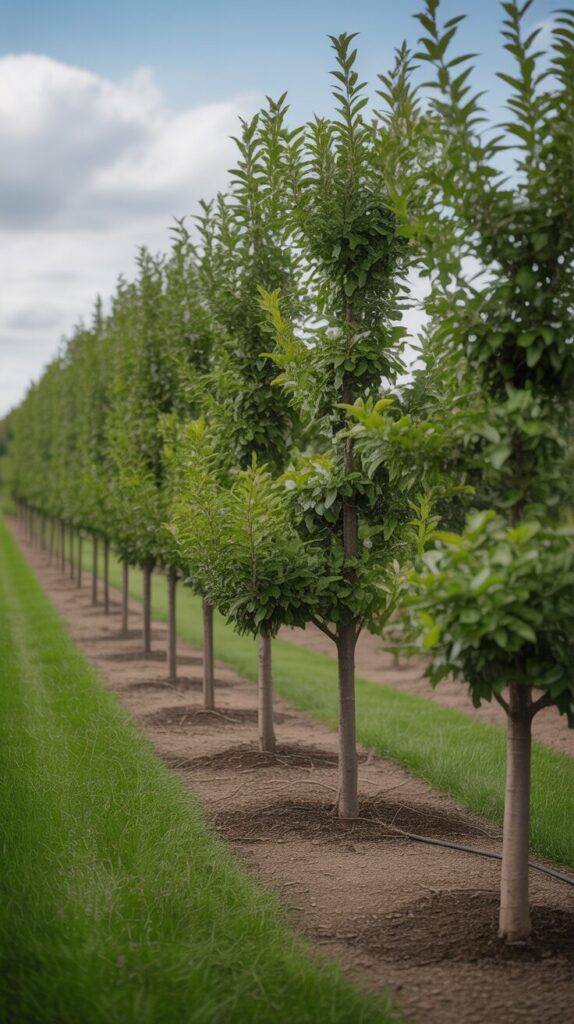
Maximize fruit production in limited space by planting dwarf or semi-dwarf trees just 3-5 feet apart in hedgerow formation for intensive yields. This commercial technique adapts beautifully to residential settings, allowing you to grow multiple varieties in the space traditionally occupied by one standard tree. The close spacing creates a continuous fruiting wall that’s easily managed from ground level without ladders, making harvesting safer and more convenient. Implement a central leader pruning system to maintain narrow tree profiles that don’t shade neighbors while encouraging abundant fruiting wood development. High-density plantings begin producing significant harvests within 2-3 years compared to 5-7 years for traditionally-spaced standard trees, providing faster returns on investment.
5. Mixed Variety Fruit Tree Grove
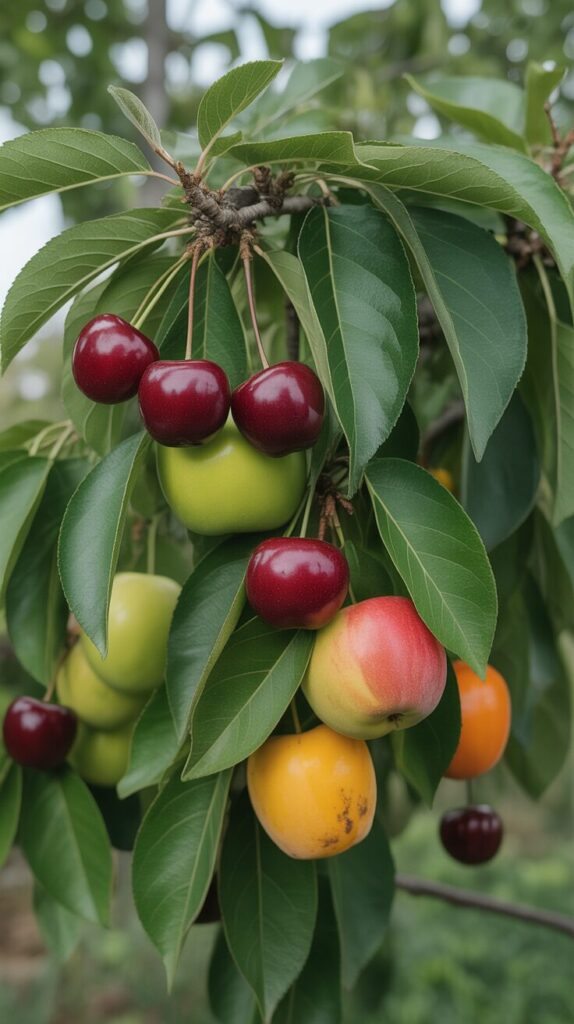
Create biodiversity and extend harvest seasons by planting diverse fruit species together rather than monoculture blocks of single types. Combine early-ripening cherries with mid-season apples, late-summer pears, and fall-harvest persimmons for continuous fresh fruit availability from May through November. The varied bloom times ensure that if late frosts damage one species, others will still produce successful crops that season. Group trees with similar water and fertilization needs together to simplify irrigation and feeding schedules while maintaining distinct planting zones for different fruit families. This approach also provides natural pest management since many fruit-specific insects won’t spread as easily through diverse plantings compared to monoculture orchards.
6. Orchard-Lawn Integration Design
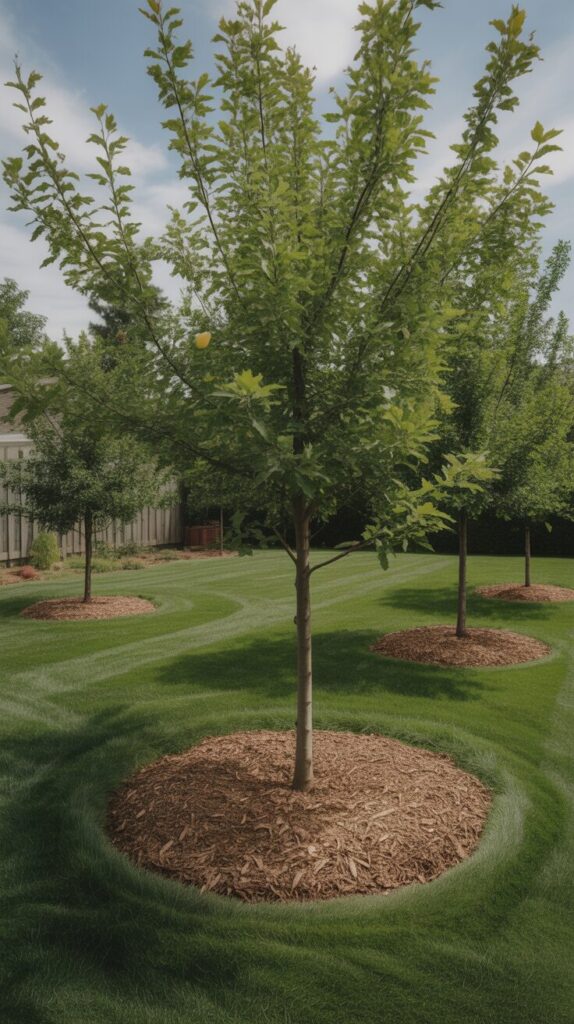
Incorporate fruit trees into existing lawn spaces by planting them in strategic locations that maintain open grass areas for recreation and activities. Position trees around the lawn perimeter or in small clusters that create natural gathering spots with dappled shade for summer outdoor living. Maintain grass-free mulch circles extending at least 3-4 feet around each trunk to eliminate mower damage and reduce competition for water and nutrients. This integrated approach lets you enjoy both productive fruit growing and traditional lawn functionality without sacrificing either completely. Plant larger shade-producing trees on the south and west sides to eventually reduce cooling costs while smaller trees can occupy sunnier north and east exposures.
7. Patio and Deck Orchard Container Garden
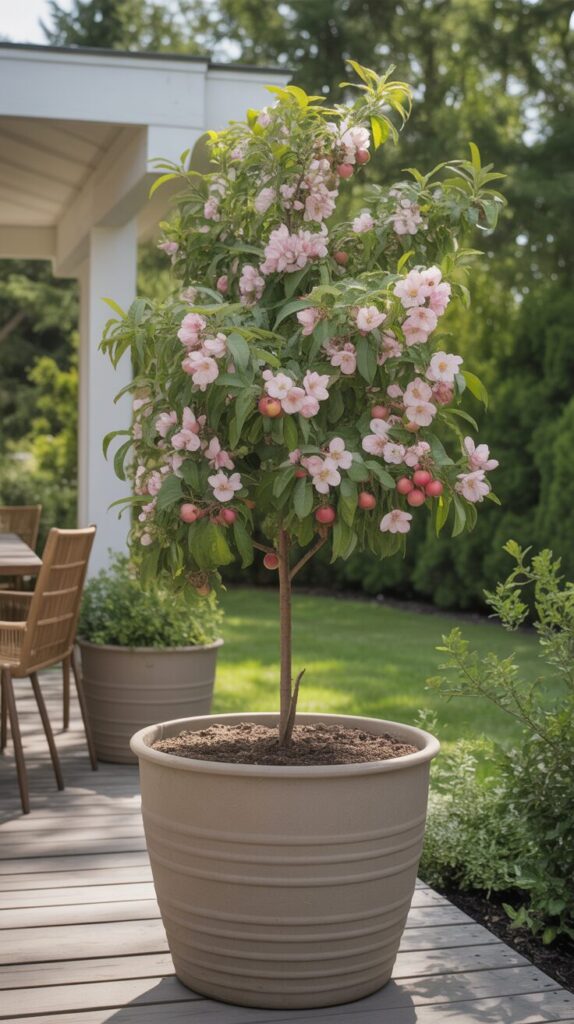
Utilize large containers on patios, decks, and hardscaped areas to grow dwarf fruit trees where in-ground planting isn’t possible or desired. Select naturally compact varieties like genetic dwarf peaches, patio apples, or columnar fruit trees bred specifically for container cultivation. Use containers at least 20-25 gallons with excellent drainage, filled with quality potting mix amended with compost for sustained nutrient availability. This portable orchard approach allows you to rearrange trees for optimal sun exposure, move them to protected locations during severe weather, or redesign your outdoor space without permanent commitments. Position containers near outdoor living areas where you’ll regularly enjoy the seasonal blossom displays and conveniently harvest fresh fruit during meals and gatherings.
8. Pollinator-Friendly Orchard Meadow
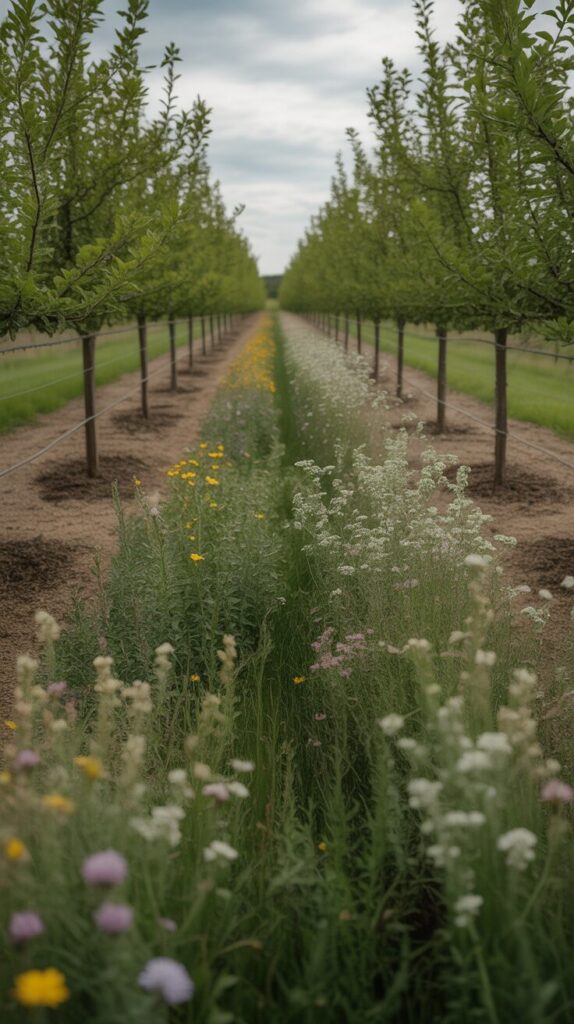
Transform your orchard floor into a flowering meadow by replacing traditional turf grass with low-growing wildflowers and beneficial plant species. Establish clover, alyssum, phacelia, and native wildflower mixes beneath fruit trees to attract essential pollinators that dramatically improve fruit set and yields. The diverse plantings provide continuous blooms from early spring through fall, supporting bee populations even when fruit trees aren’t flowering. Mow pathways through the meadow for maintenance access while leaving broad flower zones unmowed to serve as pollinator habitat throughout the growing season. This approach eliminates most mowing requirements, reduces water needs compared to traditional lawns, and creates a stunning, naturalistic orchard aesthetic that benefits local ecosystems.
9. Four-Season Backyard Orchard
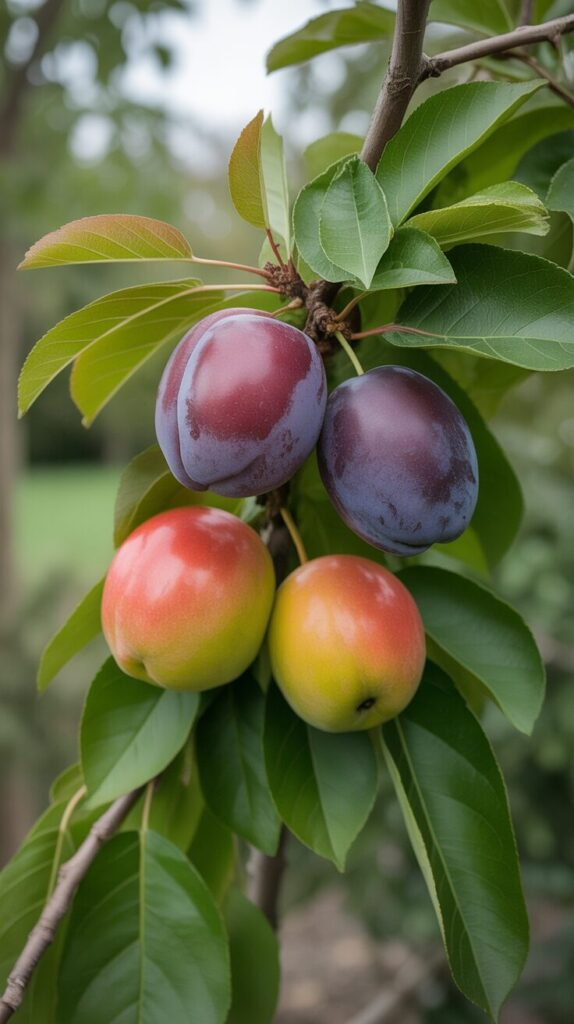
Plan your orchard to provide visual interest and harvests throughout the entire year by carefully selecting species with staggered bloom and fruiting times. Include early-flowering plums and apricots for spring beauty, summer-bearing cherries and berries, fall apples and pears, and winter-interest persimmons that hold fruit after leaves drop. Add evergreen citrus trees in mild climates or ornamental elements like fruiting crabapples that provide winter food for birds when other harvests conclude. This succession planning ensures your orchard remains an attractive, productive landscape feature during all seasons rather than lying dormant for months. Position early bloomers in warmer microclimates near buildings or south-facing locations to further extend your growing season and minimize frost damage risks.
10. Vertical Orchard Wall System
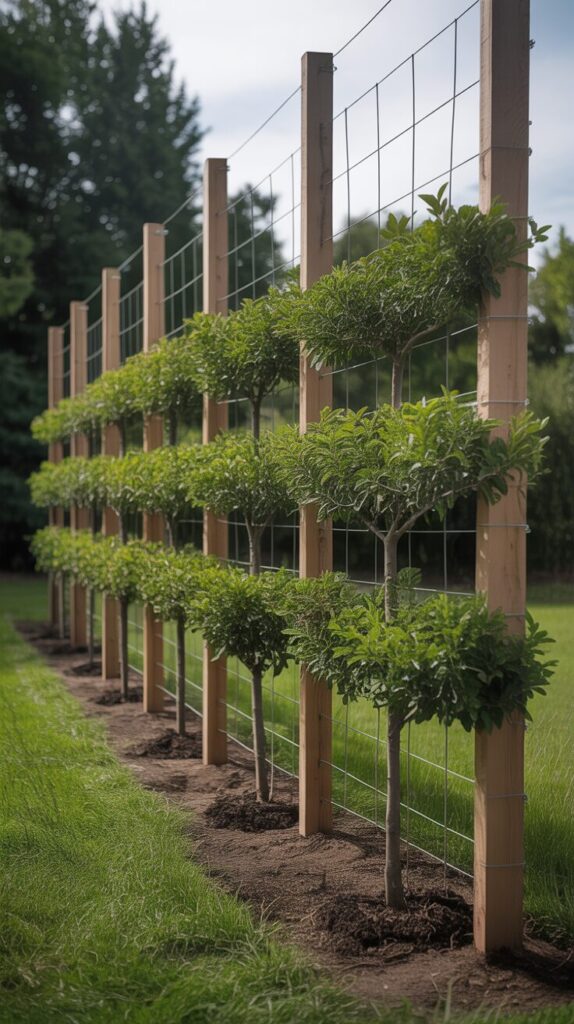
Construct sturdy vertical growing structures with horizontal supports to train multiple fruit trees into a living wall that produces abundant harvests in minimal footprint. Install pressure-treated posts every 8-10 feet with galvanized wire strung horizontally at 18-inch intervals to create a support framework for intensive plantings. Plant bare-root trees 3-4 feet apart along the wire lines, training branches horizontally as they grow to maximize fruiting wood in compact space. This system works exceptionally well along property boundaries, garage walls, or as garden dividers that provide privacy while producing food. The vertical orientation improves air circulation and sun exposure compared to traditional orchard layouts, resulting in healthier trees with better fruit quality and reduced disease pressure.
Essential Tips for Backyard Orchard Success
Site Selection and Preparation: Choose locations with full sun exposure (minimum 6-8 hours daily) and well-draining soil that doesn’t collect standing water after rain. Test soil pH and amend as needed—most fruit trees prefer slightly acidic conditions between 6.0-6.5 for optimal nutrient uptake. Remove existing grass and weeds in a 4-foot diameter circle around each planting location before installation to reduce competition during critical establishment years.
Variety Selection Strategy: Research fruit varieties bred specifically for your USDA hardiness zone and chill hour requirements to ensure successful flowering and fruiting. Consider disease-resistant cultivars that reduce spraying needs and maintenance demands while providing reliable harvests in your local climate. Select at least two compatible varieties of each fruit type that bloom simultaneously to ensure proper cross-pollination and maximum fruit set.
Planting Techniques: Dig holes twice as wide but no deeper than the root ball to encourage lateral root growth into surrounding soil. Position the graft union (visible swelling on the trunk) 2-3 inches above soil level to prevent rootstock suckering and maintain desired tree characteristics. Water thoroughly after planting and apply 3-4 inches of organic mulch around the base, keeping it pulled back several inches from the trunk.
Watering Requirements: Provide newly planted trees with deep watering once or twice weekly during the first growing season to establish strong root systems. Mature trees typically need 1-2 inches of water weekly during fruiting periods, adjusting based on rainfall and soil type. Install drip irrigation or soaker hoses to deliver water directly to root zones efficiently while keeping foliage dry and reducing disease pressure.
Pruning and Training: Begin structural pruning during the dormant season (late winter) to establish strong scaffold branches and open center or central leader forms. Remove dead, damaged, diseased, or crossing branches annually to maintain good air circulation that prevents fungal infections. Summer pruning controls excessive vegetative growth and redirects energy toward fruit production rather than leaf development.
Pest and Disease Management: Monitor trees regularly for common issues like aphids, scale, codling moth, and fungal diseases that vary by region and fruit type. Implement integrated pest management combining cultural practices, beneficial insects, organic sprays, and strategic timing rather than relying solely on chemical interventions. Clean up fallen fruit and leaves promptly to eliminate overwintering sites for pests and disease organisms that cause recurring problems in subsequent seasons.
Fertilization Schedule: Apply balanced organic fertilizer in early spring as trees break dormancy, then again in early summer for young trees still establishing growth. Mature bearing trees benefit from annual spring applications of compost or aged manure combined with targeted mineral amendments based on soil testing. Avoid over-fertilizing, which promotes excessive vegetative growth at the expense of fruit production and increases susceptibility to pest and disease problems.
Harvest and Storage: Pick fruit at proper maturity—typically when it separates easily from the branch with a gentle twist and upward lift motion. Handle harvested fruit carefully to prevent bruising, and cool it quickly to extend storage life and maintain optimal flavor and texture. Store different fruit types separately at their ideal temperatures and humidity levels, checking regularly for spoilage that can spread to healthy fruit.
Conclusion
Creating a backyard orchard transforms your property into a productive landscape that provides fresh, organic fruit while enhancing your home’s beauty and value. These ten diverse approaches demonstrate that successful fruit growing adapts to any yard size, from compact urban lots to spacious suburban properties with room for expansive plantings. The key to orchard success lies in thoughtful planning, appropriate variety selection, and consistent care during establishment years when trees develop the strong foundation for decades of production. Whether you choose a traditional row layout, innovative vertical system, or integrated food forest design, your backyard orchard will reward you with seasonal blossoms, abundant harvests, and the incomparable satisfaction of growing your own fruit. Start with a few well-chosen trees, learn from each season’s experiences, and gradually expand your orchard as your skills and confidence grow—your fruit-filled backyard paradise awaits.
Frequently Asked Questions
How much space do I need for a backyard orchard? Even small yards can accommodate 2-4 dwarf fruit trees using space-efficient techniques like espalier or high-density planting. A quarter-acre lot provides ample room for 10-15 standard trees or 20-30 dwarf varieties depending on your chosen layout and management system.
When is the best time to plant fruit trees? Late winter through early spring while trees remain dormant is ideal for bare-root planting in most climates. Container-grown trees can be planted any time during the growing season, though spring and fall plantings establish more easily than summer installations in hot weather.
How long until my trees produce fruit? Dwarf varieties typically begin bearing within 2-3 years while semi-dwarf trees produce in 3-4 years and standard trees take 5-7 years to reach significant production. High-density plantings and good care practices can accelerate fruiting timelines compared to traditionally spaced orchards with minimal maintenance.
Do I need multiple trees for pollination? Most apple, pear, plum, and cherry varieties require cross-pollination from compatible varieties blooming simultaneously for good fruit set. Peaches, nectarines, and many apricots are self-fertile and produce well alone, though yields often improve with multiple trees present for cross-pollination.
What are the best beginner fruit trees? Apples, pears, and plums generally prove most forgiving for novice growers since they tolerate various soil types and require less intensive pest management. Select disease-resistant varieties bred for your region to minimize spraying needs and maximize success rates during your learning years.

